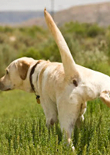Housebreaking a Puppy in Only 1 Month
By Sally Gutteridge | Posts

 Housebreaking a puppy should be your first priority the moment you take your puppy home from the breeder or the shelter. By using all of the tips listed below, housebreaking your puppy can be pleasant experience, and the skills you acquire as a trainer will last you a lifetime.
Housebreaking a puppy should be your first priority the moment you take your puppy home from the breeder or the shelter. By using all of the tips listed below, housebreaking your puppy can be pleasant experience, and the skills you acquire as a trainer will last you a lifetime.
To start housebreaking a puppy, you must first make a list of your priorities. Although it’s nice to have a puppy to play with and to teach him basic tricks, your focus should go to setting clear boundaries for your dog as to what is acceptable and what is not, so that you can keep your house clean.
The first step in housebreaking a puppy is to get a crate that is the right size. It’s important that you use a small crate that your puppy can sleep comfortably in, not a crate that is so large that he can run or move around inside. If your puppy has a large crate, he will be likely to use the toilet in one corner and sleep in another corner.
Note: If your puppy is going to significantly grow in size, purchase a crate with a blocked compartment so that he can grow into the crate as he gets older.
Don’t Leave Your Puppy Alone
When housebreaking a puppy for the first time, you can’t trust your puppy to be left alone at any time. You need to observe his every behavior to make sure that he does not wander off and use the toilet in a hidden area of the house.
If you do not constantly keep an eye on your puppy, then he may be using the toilet indoors without your knowledge. This will completely derail your housebreaking efforts since it will appear that your puppy is using the toilet outdoors at scheduled times, when he actually is not.
If you’re going to be gone for any extended period of time, keep your puppy in his crate. But before you do, you must take the time to acclimate your puppy to his crate with a positive association.
Use treats to encourage your puppy to go into his crate freely and willingly. Once your puppy becomes more comfortable with entering his crate on his own, shut him in the crate for small periods of time, starting from 5 minutes and slowly building up to an hour or two at a time.
Always reward your puppy with a treat each time that he enters the crate so that he will start to look forward to the time that he spends there.
Reward for Good Behavior
When your puppy is rewarded for good behavior, it makes housebreaking a puppy much easier because you will reinforce his good actions. Your puppy should be rewarded for the good behavior of willingly going into his crate when he is commanded.
He should also be rewarded with some treats and lots of praise whenever he uses the toilet outside in the designated area – each time that you take him outside.
When you use this consistency in housebreaking a puppy, he will soon start to look forward to using the toilet outdoors because he will expect a treat. This is the best way to reinforce good behavior with rewards.
Catch Him in the Act
When you create a schedule for housebreaking a puppy, keep in mind that your puppy will naturally want to urinate after playing and after taking a nap. Take him outside as often as possible so that he has the opportunity to use the toilet outdoors and get a delicious reward from you.
In the event that you catch your puppy using the toilet indoors – which is likely to happen in the early days of housebreaking a puppy – do not punish him. Come again? Yes, it is important to catch your puppy in the act and startle him. But instead of punishing, redirect his behavior and take him outside. As soon as he eliminates outside, he should be rewarded with a treat and lots of praise to show that he has done something good.
When you use the proper technique, housebreaking a puppy can be easily achieved in 30 days or less.
Mastering this fundamental training will make it easier to teach your dog good behavior and even advanced tricks in the future.
Good luck, if you have any questions please leave a comment below and I will do my best to address your concerns. Thank you for reading this article.
Session expired
Please log in again. The login page will open in a new tab. After logging in you can close it and return to this page.